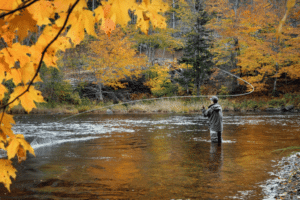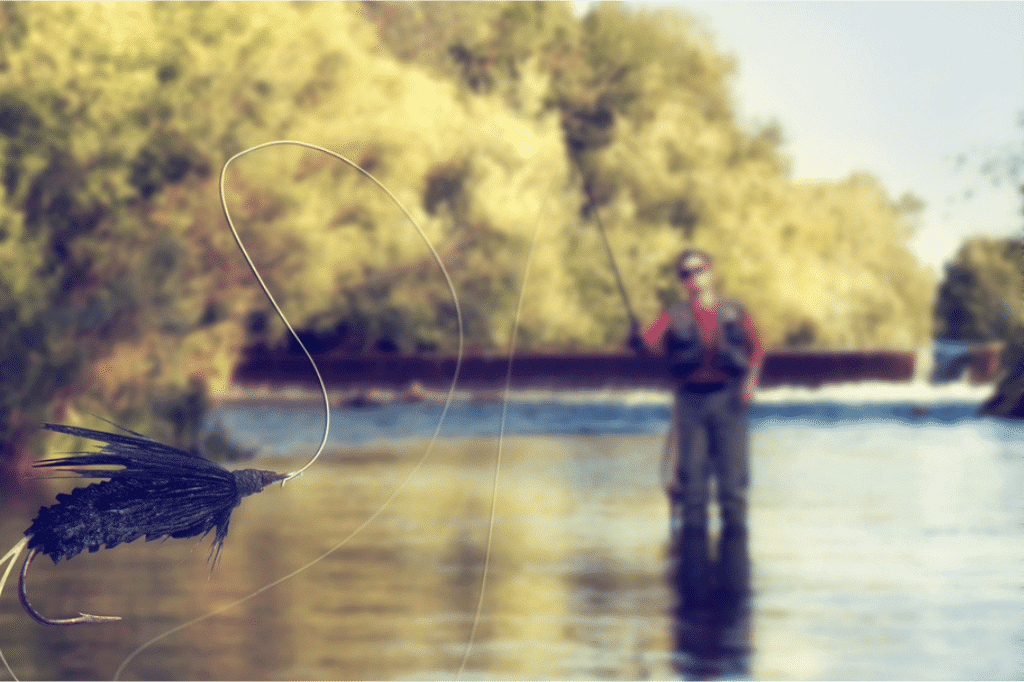Fly fishing rods are pivotal for anglers seeking a unique and effective method to catch fish in both fresh and saltwater. Crafted to provide precision and grace, these rods enable the presentation of the fly to the fish in a natural manner.
Advanced technology has led to a variety of rod materials, including carbon fiber and graphite, offering a balance of strength and sensitivity. This versatility ensures that enthusiasts can choose a rod that matches their specific needs, whether chasing small stream trout or targeting larger saltwater species. Essential for the fly fishing technique, a proper rod enhances the angler’s control and improves the overall fishing experience. With the right rod, fly fishermen can cast with accuracy and enjoy the sport at its finest.
The Lure Of Fly Fishing
The Sport’s Rich History
Fly fishing has roots reaching back centuries. It emerged as a refined sport enjoyed by many.- Origin: Traced back to 200 AD, it was described in ancient texts.
- Evolution: Developed through time, fly fishing techniques and gear have continuously improved.
- Modern Era: Today, it unites enthusiasts from all over the globe, sharing their passion for the sport.
Why Anglers Choose Fly Fishing
Many anglers turn to fly fishing for the distinct advantages it offers. It is not just a way to fish, it’s a way to connect with nature.| Precision | Challenge | Environment |
|---|---|---|
| Fly fishing demands precise casting techniques, attracting fish right to the fly. | It requires mastering diverse skills and knowledge of fish behavior and habitats. | This form of fishing encourages preservation of pristine natural environments. |

Fly Rod Basics
Rod Lengths And Their Uses
Selecting the right rod length is critical for your fishing success. Each length offers a unique advantage on the water.- Short rods (6-8 feet): Perfect for small streams and tight spots.
- Medium rods (8-9 feet): The all-rounders, balance between power and precision.
- Long rods (9-11 feet): Ideal for casting far with more control.
Material Matters: Choosing Between Bamboo, Graphite, And Fiberglass
Material choice impacts a rod’s feel and performance. Weigh the pros and cons:| Material | Feel | Flexibility | Durability | Price |
|---|---|---|---|---|
| Bamboo | Classic | High | Good | $$$ |
| Graphite | Modern | Varies | Great | $$ |
| Fiberglass | Retro | Medium | Decent | $ |
Action And Flexibility
Understanding Rod Action
Rod action refers to where a rod bends when pressure is applied. Fast action rods bend mostly near the tip. Medium action rods bend through the top half. Slow action rods bend down into the lower third. Each type has its perks. Fast action rods are great for long casts and windy conditions. Medium action rods offer versatility. Slow action rods excel in precision for short casts.Flex Profiles For Different Fishing Conditions
The rod’s flex profile impacts its suitability for various fishing scenarios. Consider the water body and target species when choosing a rod.- Small Streams: Look for a softer, slower action rod for delicate presentations.
- Large Rivers: A medium to fast action rod can handle bigger water and fish.
- Windy Conditions: Fast action rods with stiffer backbones provide better control.
- Beginners: Medium action rods offer a good starting point, being forgiving and easier to handle.
Weight And Balance
Every fly angler knows that a fly fishing rod’s weight and balance significantly affect their fishing experience. Understanding these factors helps in casting with precision and enjoying a successful fishing trip. To excel at fly fishing, select an appropriate rod weight and ensure the rod is well balanced to match the intended use and skill level.
Choosing The Right Rod Weight
Finding the perfect rod weight is essential for your fishing success. Here’s a simple guide:
- Lightweight Rods (1-4 weight): Ideal for small streams; targets tiny fish.
- Medium-range Rods (5-7 weight): Great for versatility; suits various fish sizes.
- Heavyweight Rods (8+ weight): Best for big fish; handles windy conditions.
Select the rod weight that aligns with the size of the fish you plan to catch. Do this, and your casts will feel natural and effortless.
The Importance Of Rod Balance
Properly balanced rods lead to:
- Better Control: A balanced rod offers more precision when casting.
- Less Fatigue: Balance means less strain on your wrist and arm.
- More Sensitivity: You will feel more bites and tugs on a balanced rod.
Test the balance by holding the rod at the grip. The perfect balance gives you a stable, horizontal rod. Aim for this equilibrium to ensure seamless fishing action all day long. Remember: A well-chosen rod becomes an extension of your arm. It should feel right in your hand and act as a natural part of your fishing technique. This balance between rod weight and balance will elevate your fly fishing experience to new heights!
The Handle And Grip
Handle Shapes And Comfort
Handle shapes are crucial for a steady hold. The shape should fit well in your hand. Each shape serves a different style of fishing. Common shapes include cigar, full wells, half wells, and pistol grip.- Cigar: Great for smaller streams and lightweight rods.
- Full Wells: Ideal for larger fish and heavier lines.
- Half Wells: Versatile for various fishing styles.
- Pistol Grip: Offers more wrist support for accurate casting.
Grip Materials And Durability
Grip materials can vary, but cork and EVA foam are most popular. Each has benefits that affect grip performance and durability.| Material | Benefits | Durability |
|---|---|---|
| Cork | Warm, natural feel; molds to hand | Good with proper care |
| EVA Foam | Water-resistant; easy to clean | Excellent |
Fly Rods And Reel Compatibility
Matching Rods With The Right Reels
Success in fly fishing starts with matching the rod and reel. Getting the combination right is like finding a soulmate for your fishing adventure.- Rod weight should mirror reel weight.
- Match the line weight specified on the rod with the reel.
- Consider reel size for balance in hand.
The Impact On Casting And Retrieval
Proper pairing affects casting precision and smooth retrieval. It enhances your control and comfort.| Component | Function | Effect on Casting/Retrieval |
|---|---|---|
| Rod Flexibility | Dictates casting mechanics | Improves accuracy |
| Reel Drag | Controls line release | Smoothens line flow |
| Reel Weight | Balances the rod | Reduces arm fatigue |
Caring For Your Fly Rod
Routine Cleaning
After each use, clean your rod with freshwater. Use a soft cloth to wipe down the rod to remove dirt and grime. Pay special attention to the guides by using a small brush for any trapped debris. If saltwater fishing, a thorough rinse is critical. Salt can corrode components, so ensure every part gets a freshwater bath. Once dry, apply a fine rod wax to protect its surface.Storage And Transportation Tips
- Avoid leaving the rod in direct sunlight for extended periods. UV rays can weaken the rod’s materials.
- When not in use, dismantle and store your rod in a fabric rod sock and a hard tube case.
- Prevent bending and pressure by keeping the rod away from heavy objects.
- During travel, secure the rod in the vehicle to prevent sudden jolts or impacts.

Pro Tips For Mastery
Advanced Casting Techniques
Casting is at the heart of fly fishing. With these advanced techniques, precision and grace combine for stellar performance. Let’s enhance your cast:- Double Haul: A technique that adds speed and distance to your cast.
- Roll Cast: Perfect for tight spots with limited backcast room.
- Belgian Cast: Combines overhead and side casts to navigate windy conditions.
Reading Water And Fish Behavior
Water is voluminous with stories; learning to read them is crucial. Uncover fish behavior secrets with these tips:| Water Feature | Behavioral Clue | Action Plan |
|---|---|---|
| Ripples | Indicates insect activity. | Cast upstream, let fly drift naturally. |
| Deep Pools | Fish rest in cooler, deeper waters. | Use a weighted fly to reach deeper zones. |
| Undercut Banks | Trout often hide here for protection. | Present fly close to the bank to entice a strike. |
Choosing Your Flies
Patterns For Every Season
Selecting flies for your fishing rod can be as dynamic as the seasons themselves. Each period demands a specific approach to align with the natural insect life cycles. Streams and lakes come alive with different hatchings that fish feed upon, making it vital to adapt your fly box accordingly.| Season | Recommended Flies |
|---|---|
| Spring | Mayflies, Caddisflies, Midges |
| Summer | Terrestrials, Stoneflies, Pale Morning Duns |
| Fall | Streamers, Blue-Winged Olives, Egg Patterns |
| Winter | Small Nymphs, Midge Larvae, San Juan Worms |
Matching The Hatch: Selecting The Right Fly
Observation is key in fly fishing. Watch the water and skies to see what bugs are present. This technique, known as ‘matching the hatch,’ ensures you select flies that mirror the insects fish are currently feeding on. The closer your imitation, the better the chances of a successful catch.- Study the water’s surface for insect activity.
- Notice the color and size of the insects present.
- Choose flies that resemble these characteristics.

Connecting With The Fly Fishing Community
Local Clubs And Online Forums
The warmth of a tight-knit community awaits in local clubs. They bring fly fishers together, regardless of skill level. As you converse with peers, share tips, and plan outings, your fly fishing skills will soar. Here’s how to immerse yourself in the local scene:- Joining local fly fishing clubs: Clubs host regular meet-ups and contests.
- Participating in events: They sharpen skills and offer tips.
- Online forums: These are platforms for sharing stories and advice.
- Discussion groups: Find them on social media or fly fishing sites.
Workshops And Guided Tours
Workshops and guided tours are fantastic for hands-on learning. Experts share secrets that books can’t teach. Look out for these opportunities:- Fly fishing workshops: Cover basic techniques and gear selection.
- Pro-led sessions: Dive deep into fly fishing tactics.
- Guided tours: Offer real-world fly fishing experiences.
- Expeditions: These trips often target exotic or challenging locations.
Frequently Asked Questions On Fly Fishing Rod
What Rod Is Used For Fly Fishing?
A fly fishing rod, specifically built for casting lightweight lures called flies, is necessary for the sport. These rods are typically lightweight and flexible to facilitate the unique casting techniques of fly fishing.
How Much Should I Spend On A Fly Fishing Rod?
Budget between $150 to $200 for a quality entry-level fly fishing rod. Experienced anglers may invest up to $800 for advanced features. Consider your level and commitment before purchasing.
Why Are Fly Rods So Expensive?
Fly rods are expensive due to their high-quality materials, sophisticated craftsmanship, and advanced technology, all of which enhance fishing performance and durability.
What Is The Difference Between A Fly Fishing Rod And A Regular Rod?
A fly fishing rod is designed for casting lightweight lures and includes a specialized reel, while a regular rod suits heavier bait and uses a variety of reels for casting and retrieval. Fly rods are typically longer and more flexible.
Conclusion
Choosing the right fly fishing rod significantly enhances your angling experience. It’s all about the correct blend of flexibility, strength, and length for your specific needs. Remember, a mindful selection today can lead to memorable catches tomorrow. Embrace the journey, and may your fly fishing adventures be ever rewarding.



















